9 best tabletop RPG systems to hack into a custom game
SRDs allow players to use an existing set of rules as the basis for their own RPG.
After playing your first or your fiftieth session of a tabletop RPG, it isn’t uncommon to dream about becoming the next big game designer.
However, while themes may flow abundantly, one of the biggest obstacles to designing a game is making mechanics. It can be daunting to search for inspiration in core rulebooks whose system explanations can run over a hundred pages.
Best roleplaying systems for tabletop RPG hacks
- Wretched & Alone
- Lumen
- Lost & Found
- The Caltrop Core
- Forged in the Dark
- Carta
- Charge
- Motif
- Lasers & Feelings
Thankfully, there are a growing number of RPG systems that can be easily reskinned and added to, providing budding gaming designers with a solid foundation.
The following are some of the most notable and beginner friendly to work from, having pre-existing System Reference Documents (SRDs) which help guide would-be designers in the process of thinking about and creating a fully fledged game.
1. Wretched & Alone
To make solo RPGs about struggling alone

The Wretched & Alone system was designed to facilitate creating solo RPGs about struggling alone against insurmountable odds. While it invites creators to create games with bleak outlooks and distant possibilities of success, the system is easily adaptable to any game about situations where players have an uphill struggle.
It typically uses a deck of cards to randomise prompts for players to respond to, either through written or audio record, as well as pulls from a Jenga-style block tower in the style of Dread to create escalating tension and a loss condition when the tower almost inevitably falls. All of this is recorded for posterity, either through audio or written logs, allowing players to reflect on or even share their solitary experiences.
Find the Wretched & Alone SRD on Itch.io
Designer: Chris Bisette, Matt Sanders
Wretched & Alone RPGs:
- Being Looked At by Matthew Gravelyn
- Long Haul 1983 by Sean Patrick Cain
- Horse Girl by Samuel Mui
2. Lumen
To make action-packed RPGs of vanquishing foes
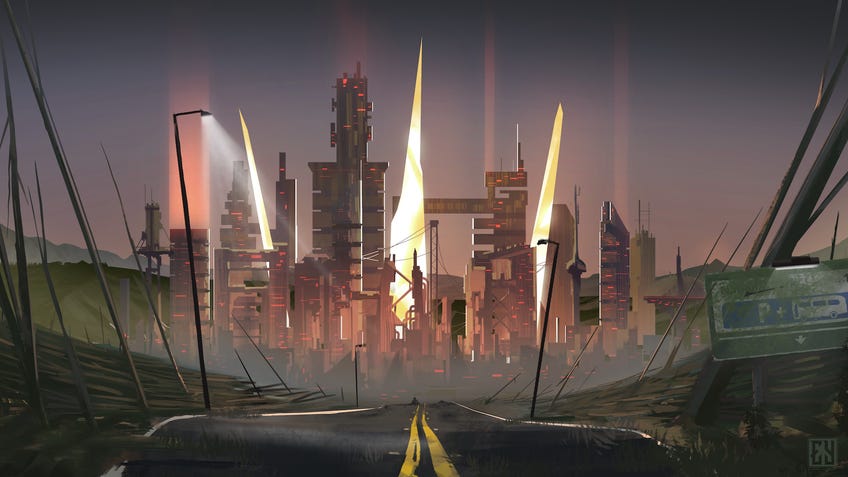
The Lumen system was designed for quick, punchy, combat-filled games, and emphasises telling the stories of powerful characters on thrilling missions. It prides itself on being rules-lite, boiling down all actions to a simple d6 system, with much of its creative thrust contained within the balance of Powers and Weapon use in play.
Harkening back to the fast-paced energy of looter-shooter video games like Destiny, it utilises dropped loot from vanquished enemies to make sure that use of your abilities is not about resource management but explosive fun. The system also employs tags - quick descriptors with narrative and mechanical impacts - making it easy to give weapons, bosses and other game elements identifying features to play around.
Find the Lumen SRD on Itch.io
Designer: Spencer Campbell
Lumen RPGs:
- Nova by Spencer Campbell
- In Extremis by Keganexe
- Hedge by A Couple of Drakes
3. Lost & Found
To make contemplative RPGs about legacy
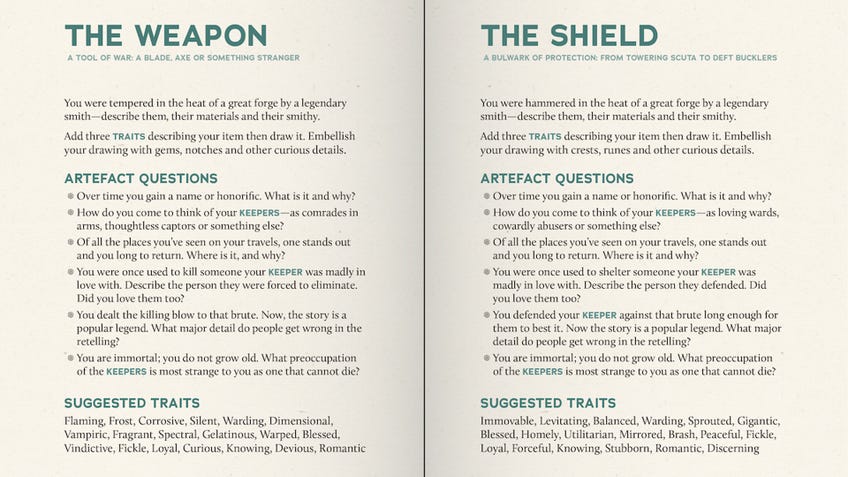
Lost & Found seeks to have players create stories of remembrance, nostalgia and oddly philosophical pondering. Its core concept is founded on objects, both tangible and intangible, being passed on from one person to another.
Through a series of guiding questions and prompts, players see through and endure games whose scope encompasses years, decades or even millennia. There is also an unusual passive observation in this approach - rather than objects having their own agency they are wielded by a revolving series of agents, whose lives are reflected on in passing.
Find the Lost & Found SRD on Mousehole Press
Designer: Jack Harrison
Lost & Found RPGs:
- Artefact by Jack Harrison
- Mythmaker by K.W.
- Blood Vessels by stargazersasha
4. The Caltrop Core
To make RPGs that utilise the underloved d4
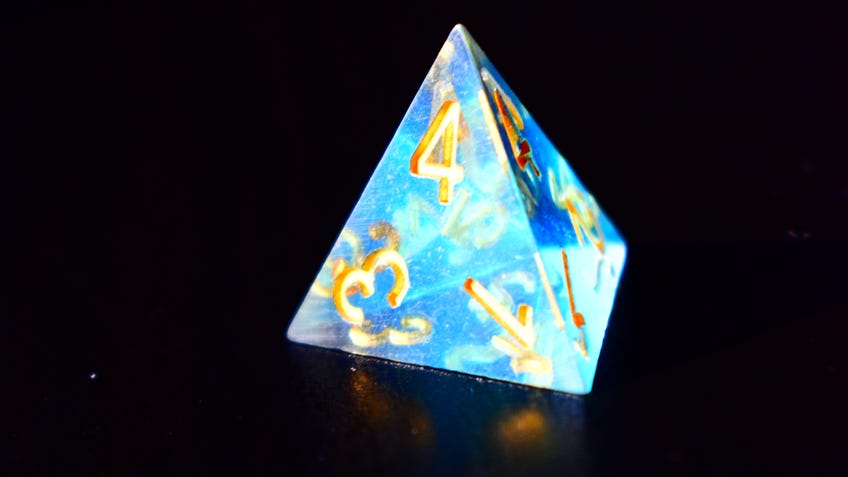
A newer system created without being attached to an existing game, one of the most unique selling points of The Caltrop Core is that it makes use of the humble d4, that most universally maligned of dice. Success or failure exists in one of four states: Absolute Failure, Partial Failure, Partial Success and Absolute Success, each assigned to one of the dice faces.
The joy in a purely mechanical system to work in is that there are no constrictions of theme, no need to narrow focus to fit the mechanics. It also lacks the fickleness of a larger dice pool, creating a lean, mean play experience to build any number of worlds around.
Find the Caltrop Core SRD on Itch.io
Designer: TitanomachyRPG, @aghostofeli, @n_quests
The Caltrop Core RPGs:
- I Adjure You, Ancient Serpent by AA Voigt
- Dragoons & Dragons by Maps ‘N’ Quests
- Party Animals by Dani Belonia
5. Forged in the Dark
To make daring RPGs with high stakes
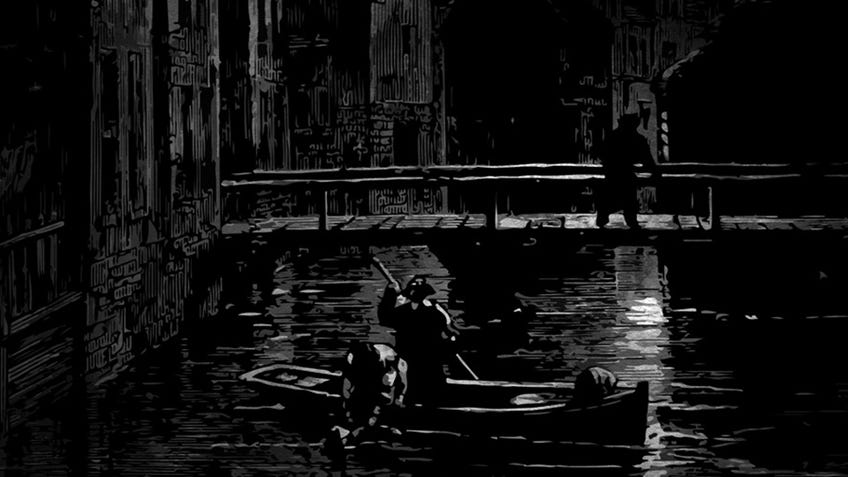
Of the RPG systems in this article, Forged in the Dark is likely the most well known due to its use in Blades in the Dark. Players adapt a character from a series of set origins and playbooks, a collection of attributes, skills and items that serve as a fixed template from which characters can improve and upgrade their capabilities. Rather than tracking obstacles such as enemies and hazards as a list it makes use of clocks that tick ever forward, possibly backwards, to denote progression in either direction.
Innovative mechanics like the Flashback, which allows players to narrate the ways in which they’ve prepared for circumstances sprung on them by the GM, also serve to give game designers the tools to create dynamic games in a wide number of genres. All of this is served by a simple system of d6 dice pools.
Find the Forged in the Dark SRD on the Blades in the Dark website
Designer: John Harper
Forged in the Dark RPGs:
- Band of Blades by Stras Acimovic and John LeBoeuf-Little
- Enter the Survival Horror by Adam Bucceri
- Crescent Moon by Ema Acosta
6. Carta
To make RPGs of exploration and survival
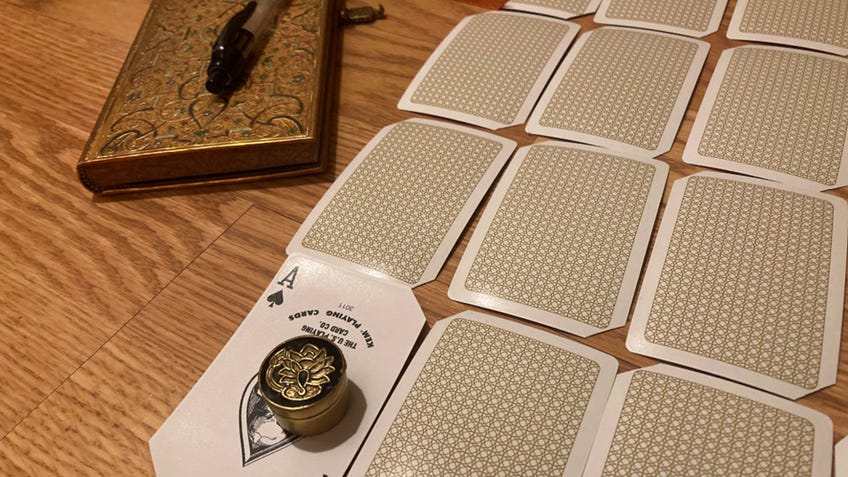
A game system that makes use of playing cards for play and resolution instead of the dice traditional to tabletop RPGs, Carta games focus on exploration over combat. A player, or players, will physically move a token that represents them over a grid of cards, with each card denoting a different prompt to respond to.
Much like in Wretched & Alone, each suit corresponds to one of four prompt-types, allowing players to anticipate what type of obstacle or question they will have to face. The addition of resources - tokens that can be collected or explored the further the game goes on - helps replicate the struggle for survival on the way to the final goal card.
Though typically geared towards the creation of games for solo play, there is no small number of Carta games that have been amended to allow for a collaborative or even competitive exploration.
Find the Carta SRD on Itch.io
Designer: Peach Garden Games
Carta RPGs:
- Into the Glacier by Peach Garden Games
- Two Stand to Fall by Amorphous and Empwnleon
- The Land and the People by Hessan Yongdi
7. Charge
To make impactful RPGs with forward momentum

Charge is another system for hacking that was created system-first, hosted entirely online at Fari Games. It takes much of the set dressing in RPG systems like Resistance and Forged in the Dark, stripping them down to their core elements. Character creation is simplified to basic details (a character’s concept, appearance and ties to others in the world) and allocation of action dots.
Gameplay runs on a series of basic d6 dice pools, with the significant addition of Momentum - a measure of impact on the world that can be called on for mechanical benefits when a charge of it is utilised. While the generic nature of the system means that at its base it can be used wholesale with any story, it benefits from active community participation in the creation of extras - new features and additions to change the game experience.
Find the Charge SRD on Fari Games
Designer: René-Pier Deshaies-Gélinas
Charge RPGs:
- Solo Extra by Valdy
- Personal Weapons Extra by Keita Creations
- Magic Extra by Nuagia
8. Motif
To make RPGs of finding answers in the world

Motif is an RPG system based around oracles, used not only to determine success and failure but to produce answers to questions.
Your first die is the Answer - whether your action, your question or the universe produces a yes, no or maybe. Your second die is Impact - how much the answer resonates and affects you and what is around you. Your third die is Flavour, adjustable to subsystems and variable depending on the game being played.
It is on this simple foundation that variations on character ability, advancement and progression are easily built upon. Games can have any theme under Motif, but typically they embody the spirit of the Motif dice by asking players to search for some kind of answers in the world players find themselves in.
Find the Motif SRD on DriveThruRPG
Designer: Thought Police
Motif RPGs:
- No Angels Live Here by Thought Police
- The Princess and the Dragon by Thought Police
- We Came in Peace by Thought Police
9. Lasers & Feelings
To make simple RPGs of balancing one or the other

Lasers & Feelings earns its place here through the sheer simplicity of both playing and creating a game using its RPG system.
A “Lasers & Feelings” game makes use of two equal and contrasting stats, with all player characters skewing towards one statistic or the other. Player creation is a simple matter of picking two different descriptors from a set list, then balancing stats - the same for anything extra that needs to be made.
As for the play scenario? Random roll tables are used to generate the core basics, eschewing the heavy layers of background material in other games. Most Lasers & Feelings games can be simply presented on a single page, though there is space to play around with both expanded mechanics and expanded settings.
Find the Lasers & Feelings SRD on Itch.io
Designer: John Harper
Lasers & Feelings RPGs:
- Boy Problems by Colin Cummings
- Guns & Repression by Cat Elm
- The Workplace by Matteo Sciutteri




